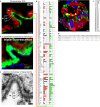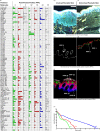Advances in toponomics drug discovery: Imaging cycler microscopy correctly predicts a therapy method of amyotrophic lateral sclerosis
- PMID: 25869332
- PMCID: PMC4676937
- DOI: 10.1002/cyto.a.22671
Advances in toponomics drug discovery: Imaging cycler microscopy correctly predicts a therapy method of amyotrophic lateral sclerosis
Abstract
An imaging cycler microscope (ICM) is a fully automated (epi)fluorescence microscope which overcomes the spectral resolution limit resulting in parameter- and dimension-unlimited fluorescence imaging. This enables the spatial resolution of large molecular systems with their emergent topological properties (toponome) in morphologically intact cells and tissues displaying thousands of multi protein assemblies at a time. The resulting combinatorial geometry of these systems has been shown to be key for in-vivo/in-situ detection of lead proteins controlling protein network topology and (dys)function: If lead proteins are blocked or downregulated the corresponding disease protein network disassembles. Here, correct therapeutic predictions are exemplified for ALS. ICM drug target studies have discovered an 18-dimensional cell surface molecular system in ALS-PBMC with a lead drug target protein, whose therapeutic downregulation is now reported to show statistically significant effect with stop of disease progression in one third of the ALS patients. Together, this clinical and the earlier experimental validations of the ICM approach indicate that ICM readily discovers in vivo robustness nodes of disease with lead proteins controlling them. Breaking in vivo robustness nodes using drugs against their lead proteins is likely to overcome current high drug attrition rates.
Keywords: ALS; MELC; drug discovery; functional superresolution; high content analysis; imaging cycler microscopy; topology; toponome.
© 2015 The Author. Published by Wiley Periodicals, Inc, on behalf of ISAC.
Figures



Similar articles
-
Next-generation biomarkers based on 100-parameter functional super-resolution microscopy TIS.N Biotechnol. 2012 Jun 15;29(5):599-610. doi: 10.1016/j.nbt.2011.12.004. Epub 2011 Dec 21. N Biotechnol. 2012. PMID: 22209707 Review.
-
On the origin of cell functions encoded in the toponome.J Biotechnol. 2010 Sep 15;149(4):252-9. doi: 10.1016/j.jbiotec.2010.03.009. Epub 2010 Apr 1. J Biotechnol. 2010. PMID: 20362632 Review.
-
Life-Saving Microscopy Method for Amyotrophic Lateral Sclerosis Patients.Cytometry A. 2020 Sep;97(9):866-868. doi: 10.1002/cyto.a.24039. Epub 2020 Jun 8. Cytometry A. 2020. PMID: 32510815
-
Systematic, spatial imaging of large multimolecular assemblies and the emerging principles of supramolecular order in biological systems.J Mol Recognit. 2014 Jan;27(1):3-18. doi: 10.1002/jmr.2326. J Mol Recognit. 2014. PMID: 24375580 Free PMC article. Review.
-
Toponomics and neurotoponomics: a new way to medical systems biology.Expert Rev Proteomics. 2008 Apr;5(2):361-9. doi: 10.1586/14789450.5.2.361. Expert Rev Proteomics. 2008. PMID: 18466063 Review.
Cited by
-
Large molecular systems landscape uncovers T cell trapping in human skin cancer.Sci Rep. 2016 Jan 13;6:19012. doi: 10.1038/srep19012. Sci Rep. 2016. PMID: 26757895 Free PMC article.
-
Image-Based Profiling of Synaptic Connectivity in Primary Neuronal Cell Culture.Front Neurosci. 2018 Jun 26;12:389. doi: 10.3389/fnins.2018.00389. eCollection 2018. Front Neurosci. 2018. PMID: 29997468 Free PMC article. Review.
-
Highly Multiplexed Imaging Uncovers Changes in Compositional Noise within Assembling Focal Adhesions.PLoS One. 2016 Aug 12;11(8):e0160591. doi: 10.1371/journal.pone.0160591. eCollection 2016. PLoS One. 2016. PMID: 27519053 Free PMC article.
-
New Technologies to Image Tumors.Cancer Treat Res. 2020;180:51-94. doi: 10.1007/978-3-030-38862-1_2. Cancer Treat Res. 2020. PMID: 32215866 Free PMC article.
References
-
- Schubert W. Toponomics. In: Dubitzky W, Wolkenhauer O, Cho KH, Yokota H, editors. Encyclopedia of Systems Biology. New York: Springer; 2013. pp. 2191–2212. . In:, editors. doi: 10.1007/978-1-4419-9863-7_631. ISBN 978-1-4419-9862-0. - DOI
-
- Schubert W. Topological proteomics, toponomics, MELK-technology. Adv Biochem Eng Biotechnol. 2003;83:189–209. . doi: 10.1007/3-540-36459-5_8. - DOI - PubMed
-
- Van Regenmortel MHVV. Reductionism and complexity in molecular biology. EMBO Rep. 2004;5:1016–1020. . doi: 10.1038/sj.embor.7400284. - DOI - PMC - PubMed
-
- Schubert W, Gieseler A, Krusche A, Serocka P, Hillert R. Next-generation biomarkers based on 100-parameter functional super-resolution microscopy TIS. Nat Biotechnol. 2012;29:599–610. . doi: 10.1016/j.nbt.2011.12.004. - DOI - PubMed
-
- Schubert W. Systematic, spatial imaging of large multimolecular assemblies and the emerging principles of supramolecular order in biological systems. JMR. 2014;27:3–18. . doi: 10.1002/jmr.2326. - DOI - PMC - PubMed
Publication types
MeSH terms
Substances
LinkOut - more resources
Full Text Sources
Other Literature Sources
Medical
Miscellaneous

